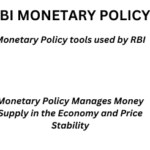Current account deficit amounted to 1.1% of GDP in First quarter: Basics Explained


As per the data released by the Reserve Bank of India (RBI) India’s current account deficit (CAD) rosed to $9.2 billion in the first quarter(April-June) of 2023-24. It amounted to 1.1 percent of GDP; a higher trade deficit coupled with a lower surplus in net services and a decline in private transfer receipts.
LEARNING FROM HOME/ WITHOUT CLASSES/ BASICS
A trade deficit is an economic measure of international trade in which a country’s imports exceed its
exports. A trade deficit represents an outflow of domestic currency to foreign markets. It is also referred to as a negative balance of trade (BOT).
Trade Deficit = Total Value of Imports – Total Value of Exports
Nations of the world record their trades in their balance of payment (BOP) ledgers. BOP of India is a systematic statement of all economic transactions between the residents of India and the residents
of the rest of the world in an accounting period (say one year).
One of the primary accounts in the balance of payments is the current account, which keeps track of the goods and services leaving (exports) and entering (imports) a country; traded with the rest of the world. The excess of imports of goods and services over their export is referred to as Current Account Deficit (CAD).
The BoP as a classification format classifies the BoP account into two:
Current account transactions that involve exports and imports of goods and services (services are incorporated under invisible). And
Capital account transactions that involve the flow of investable money to and from India. Ex: Foreign Direct Investment /Foreign Institutional Investment/ Loans
The current account has two components – exports and imports of goods and exports and imports of Invisibles (including services, remittances, and income). Hence the current account has two sub-components:
a.) Merchandise trade account: gives the money value of India’s exports and imports of goods.
b.) Invisible account: indicate India’s
(1) Service exports and imports (software exports, tourism revenues, etc, various service imports)
(2) Remittances (private remittances from abroad and payments to foreign countries)
(3) Income (income earned by MNCs from their investment in India).
ANATOMY OF CAD
A higher CAD is not necessarily bad if the bulk of it is on account of such imports that help exports and growth and is financed through the higher inflow of foreign direct investment. But the slowing economy and a growing CAD make a lethal combination. While the former would tend to discourage foreign capital inflows, the latter would have a cascading impact on inflation and the competitiveness of Indian exports.






0 Comments